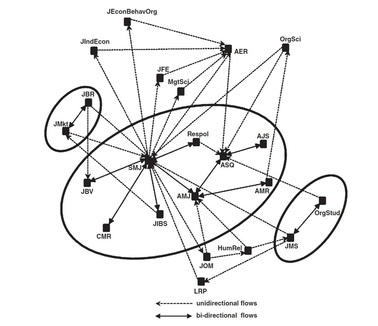 Administrative Science Quarterly is a generalist journal covering a wide range of research on organizations, as you can see in its invitation to contributors. One might think this would make it less influential in any particular topic, but this is not true. The leading generalist journals are seen as more prestigious than specialized journals, and as a result they get top quality papers, especially if those papers are meant to have wide impact. This gives them more readers, and readers who pay more attention. Equally important, generalist journals are places that assemble papers with multiple ideas that can cross-fertilize fields of study. Often they are the places to look for ideas that will grow and rejuvenate fields. So is that true for ASQ and strategy? A paper by Sridhar Nerur, Abdul Rasheed, and Alankrita Pandey looks at how strategy developed over time, focusing on research in Strategic Management Journal and journals that cited it, or were cited by it. This inflates the influence of SMJ a bit, but is fair enough because SMJ is the leading specialist strategy journal. Next they looked at citations between journals staggered in time periods. These changed over time, as strategy research took shape, but I think that the figure below is a good example because it shows 1995-1999, which was a time period in which the strategy field nearly had its current shape. Notice that there are two-way arrows between the leading generalist journals ASQ and AMJ (Academy of Management Journal), and ASQ and ASR (American Sociological Review). Other than that, all the arrows show journals learning more from ASQ than ASQ learns from them – they are one-way arrows (the arrows point in the direction of citations, so an arrow into a journal means a citation to the journal, which is the same as acknowledging influence from the journal – confusing, I know, but important). Interestingly, in this time period, there is no direct influence from ASQ to SMJ, so we cannot see ASQ shaping strategy directly, but we can track indirect influences such as ASQ to ResPol (Research Policy) to SMJ. This pattern of indirect influence started in 1990; before that ASQ directly influenced strategy. Does this mean that ASQ was a starting point that lost influence? Not at all. In fact, all these journals cite each other, so the graph just shows the highest-volume citation paths. When adding up the paths, the total influence can be found, and Nerur, Rasheed, and Pandey show that ASQ maintained a top 3 rank as a source of new strategy knowledge in all time periods except 1985-1989. They also show a broader point—in the top 5 most influential journals in strategy, only one was a specialist: SMJ. So we know that ASQ is influential in strategy, but it is not a strategy journal. It is a prestigious generalist journal, which makes it influential in many fields. Nerur, S., Rasheed, A. A., & Pandey, A. 2016. Citation footprints on the sands of time: An analysis of idea migrations in strategic management. Strategic Management Journal, 37(6): 1065-1084. Comments are closed.
|
Blog's objectiveThis blog is devoted to discussions of how events in the news illustrate organizational research and can be explained by organizational theory. It is only updated when I have time to spare. Archives
May 2024
Categories |
 RSS Feed
RSS Feed